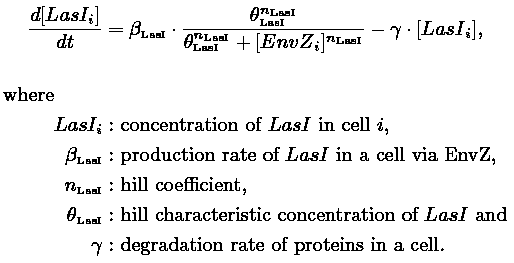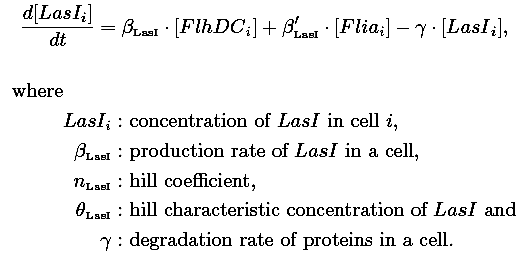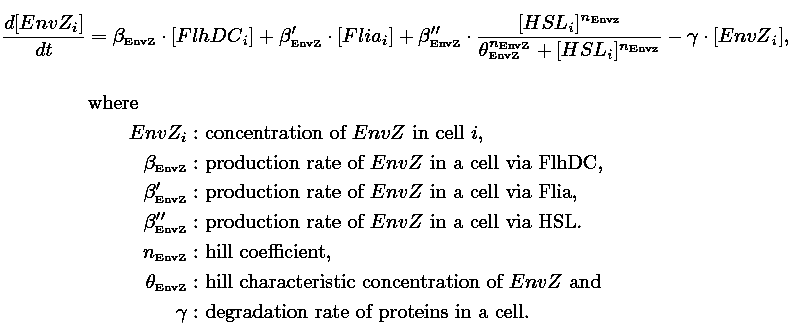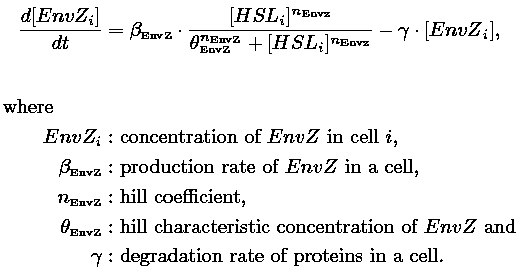Team:Paris/Analysis/Construction2
From 2008.igem.org
(→Description) |
(→Description) |
||
| Line 153: | Line 153: | ||
<TD COLSPAN=2> a) The expression of ''lasI'' is under the control of the same promotor that used for FlhDC.</TD> | <TD COLSPAN=2> a) The expression of ''lasI'' is under the control of the same promotor that used for FlhDC.</TD> | ||
<TD COLSPAN=2> a) The expression of ''lasI'' is regulated by FlhDC and Flia (as in the core system). </TD> | <TD COLSPAN=2> a) The expression of ''lasI'' is regulated by FlhDC and Flia (as in the core system). </TD> | ||
| + | </TR> | ||
| + | |||
| + | |||
| + | <TR ALIGN=CENTER VALIGN=MIDDLE> | ||
| + | <TD COLSPAN=2>[[Image:LasIEqInBIMOdularSys.png|550px]]</TD> | ||
| + | <TD COLSPAN=2>[[Image:LasIEqInUNIModularSys.png|550px]]</TD> | ||
</TR> | </TR> | ||
| Line 159: | Line 165: | ||
<TD COLSPAN=2> b) The expression of ''envZ'' depends on both the activation from FlhDC and Flia (as in the core system) and the concentration of HSL present in the cell.</TD> | <TD COLSPAN=2> b) The expression of ''envZ'' depends on both the activation from FlhDC and Flia (as in the core system) and the concentration of HSL present in the cell.</TD> | ||
<TD COLSPAN=2> b) The expression of ''envZ'' varies as a function of the concentration of HSL present in the cell.</TD> | <TD COLSPAN=2> b) The expression of ''envZ'' varies as a function of the concentration of HSL present in the cell.</TD> | ||
| + | </TR> | ||
| + | |||
| + | <TR ALIGN=CENTER VALIGN=MIDDLE> | ||
| + | <TD COLSPAN=2>[[Image:EnvZInBIMOdularSys.png|550px]]</TD> | ||
| + | <TD COLSPAN=2>[[Image:EnvZInUNIModularSys.png|550px]]</TD> | ||
</TR> | </TR> | ||
Revision as of 00:17, 28 October 2008
|
Model Construction
MotivationWe are interested to understand the factors that account for an oscillating behaviour at population level. We build two models to study systems that are equipated with quorum sensing capabilities but that relay on different designs principles. The proposed models are:
Both the bimodular and unimodular models describe events that happend not only at the cellular level (as in the core system) but also at the population level due to interactions needed bettwen a cell and its environment during quorum sensing. In the following sections, we first describe the population modeling (the common part amoung our two proposed models) to then focus our attention to the characteristics that are exclusive to each of the modeling alternatives. Description
Parameters SearchThe following table sumarize our findings. The parameters' values that are used during the simulations. Most them are found in literature others are obtained from further analysis.
|
||||||||||||||||||||||||||||||||||||||||||||||||||||||||||||||||||||||||||||||||||||||||||||||||||||
 "
"






